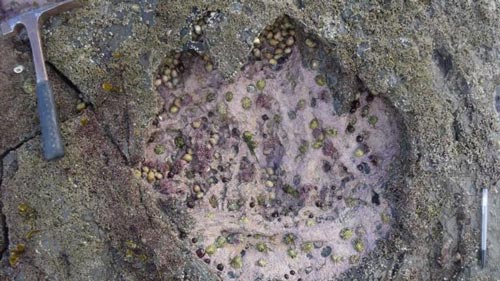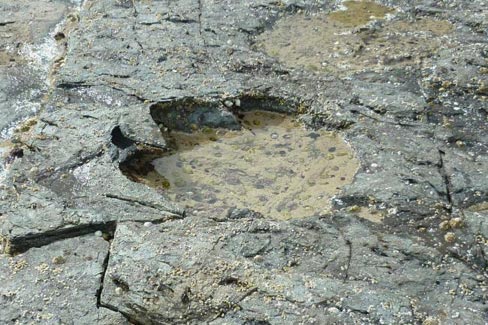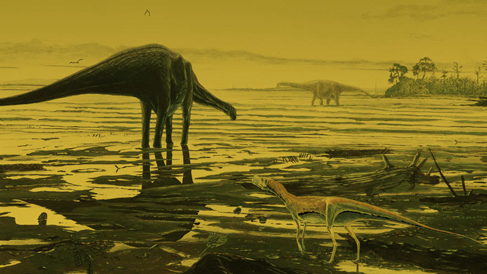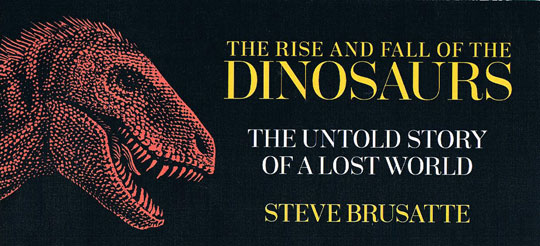Middle Jurassic Dinosaur Tracks Put Skye Firmly on the Map
More evidence of Middle Jurassic dinosaurs on the Isle of Skye has emerged. In a paper published in the Scottish Journal of Geology, a team of international scientists including researchers from the University of Edinburgh and the Chinese Academy of Sciences, report on a series of dinosaur prints and tracks from the Lealt Shale Formation (Bathonian faunal stage) of the Great Estuarine Group at Rubha nam Brathairean (Brothers’ Point), on the Trotternish peninsula (Isle of Skye).
Middle Jurassic Dinosaurs
Evidence of Middle Jurassic dinosaurs is globally rare, there are just a few fossil sites that provide information about terrestrial fauna that existed around 168 million years ago. Trace fossils from the Isle of Skye are playing an increasingly significant role as palaeontologists seek to better understand the evolution and distribution of different types of dinosaur.
One of the Sauropod Prints at Rubha nam Brathairean
Picture credit: Jon Hoad
In 2015, Everything Dinosaur published an article featuring the discovery of a series of sauropod prints and tracks found on northern Skye, at a locality close to Duntulm Castle (Duntulm Formation).
To read this article: Isle of Skye Sauropods and their Water World.
Although, the Duntulm Castle site is just a few miles from the newly described trace fossils at Brothers’ Point and the strata in which the footprints and tracks were found are part of the Great Estuarine Group sequence of Middle Jurassic rocks, the two fossil sites represent different sub-units of strata. The Lealt Shale Formation is geologically older than the fossiliferous rocks found at the Duntulm Castle site (Duntulm Formation).
Brackish, Lagoonal Environments Occupied by Middle Jurassic Dinosaurs
Both locations represent a sequence of deposits made in brackish, lagoonal environments. The fact that a second series of sauropod tracks and prints have been found preserved in rocks laid down in a lagoon, strengthens the idea that Middle Jurassic sauropods habitually spent time in these environments. Could this indicate that at least some Middle Jurassic sauropods were semi aquatic?
Did Middle Jurassic Sauropods Habitually Hang Out in Lagoons?
Picture credit: Jon Hoad
Around Fifty Footprints Measured and Studied
The researchers measured, photographed and analysed around fifty footprints in a tidal area. Working conditions on the rugged headland were difficult, due to the tidal environment and the often, inclement weather for which, the Trotternish peninsula is famed. Despite the harsh conditions, the scientists were able to identify two trackways and many examples of isolated prints.
The location preserves numerous small sauropod manus (hand) and pes (foot) prints along with several isolated and broken medium-to-large tridactyl prints. The three-toed (tridactyl) prints indicate the presence of theropods (most probably carnivorous dinosaurs). Measurements of the sauropod tracks and stride lengths indicate that these trace fossils were made by relatively small members of the Sauropoda, the tracks indicate individuals around two metres high at the shoulders.
The sauropod tracks, with their characteristic narrow gauge and toe morphology, have been tentatively assigned to the ichnotaxon Breviparopus. The theropod trackmaker remains equally enigmatic, however, some of the three-toed prints are reminiscent of the tracks associated with the ichnotaxon Eubrontes.
One of the Sauropod prints from the Lealt Shale Formation

Picture credit: Paige dePolo (University of Edinburgh)
Commenting on the Discovery
Commenting on the significance of this discovery, one of the authors of the scientific paper, Paige E. dePolo (University of Edinburgh) stated:
“This tracksite is the second discovery of sauropod footprints on Skye. It was found in rocks that were slightly older than those previously found at Duntulm on the island and demonstrates the presence of sauropods in this part of the world through a longer timescale than previously known. This site is a useful building block for us to continue fleshing out a picture of what dinosaurs were like on Skye in the Middle Jurassic.”
Co-author Dr Stephen Brusatte (University of Edinburgh), added:
“The more we look on the Isle of Skye, the more dinosaur footprints we find. This new site records two different types of dinosaurs — long-necked cousins of Brontosaurus and sharp-toothed cousins of T. rex — hanging around a shallow lagoon, back when Scotland was much warmer and dinosaurs were beginning their march to global dominance.”
A Fossil Bias?
Although the discovery of a second site, demonstrating sauropod tracks in a lagoonal depositional environment, raises the intriguing idea that these large, long-necked herbivores spent time in such environments, palaeontologists have to be careful what they infer from such data. Sauropods may have spent much of their time in different habitats, such as forests, or perhaps, in more open environments such as fern prairies, however, in such environments the fossil preservation potential for things like tracks and footprints are that much lower. Hence, the evidence for such behaviour may not exist, there could be a preservational bias in favour of recording sauropod activity in brackish lagoons.
Thanks to this dedicated research team, more information has been obtained with regards to the Middle Jurassic palaeofauna of Scotland. We look forward to future discoveries and fossil finds that will continue to inform the debate.
For models and replicas of sauropods and other dinosaurs: Wild Safari Ltd Prehistoric World Dinosaurs.
The scientific paper: “A Sauropod-dominated Tracksite from Rubha nam Brathairean (Brothers’ Point), Isle of Skye, Scotland” by Paige E. dePolo, Stephen L. Brusatte, Thomas J. Challands, Davide Foffa, Dugald A. Ross, Mark Wilkinson and Hong-yu Yi published in the Scottish Journal of Geology
“The Rise and Fall of the Dinosaurs” by Dr Steve Brusatte
One of the authors of this scientific paper (indeed one of the authors of the 2015, Duntulm Formation tracks research), Dr Steve Brusatte (School of Geosciences at Edinburgh University), has a new dinosaur book out next month. Look out for the excellent “The Rise and Fall of the Dinosaurs” coming into shops in May.
New Dinosaur Book Out Very Soon
Picture credit: Pan Macmillan
To read Everything Dinosaur’s recent book review: A Review of “The Rise and Fall of the Dinosaurs”.
Visit the Everything Dinosaur website: Everything Dinosaur.









Leave A Comment